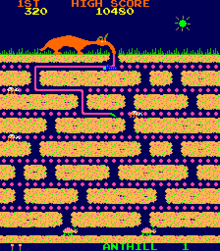Anteater (video game)
Anteater (The Anteater in Britain; Ameisenbär in Germany) is an arcade game designed by Chris Oberth and released in 1982 by Tago Electronics.[2] Though the arcade game was not a hit, it spawned a number of direct clones for home computers, some of which became better known than the original. The current high score holder is Maria Blasucci.[3]
| Anteater | |
|---|---|
 | |
| Developer(s) | Stern Electronics |
| Publisher(s) | Tago Electronics |
| Designer(s) | Chris Oberth[1] |
| Platform(s) | Arcade |
| Release | 1982[1] |
| Genre(s) | Maze |
| Mode(s) | Single player, Up to 2 players, alternating turns |
| Cabinet | Vertical |
| CPU | Z80 |
| Sound | Z80 AY8910 |
| Display | Raster, 224 x 256 pixels, 99 colors |
Gameplay
The player controls an anteater that elongates his tongue through maze-like anthills eating ants. The player can only eat ants with the tip of the anteater's tongue. If an ant bites the tongue at any other location, then the player loses a life. Pressing the second button will quickly retract the anteater's tongue. Worms will not harm the anteater unless eaten head first, in which case the player loses a life. Worms can be safely eaten from behind. Eating queen ants at the very bottom of the nest will temporarily clear all ants and worms from the screen. Once the sun has traveled across the screen and night falls, a spider will appear. The spider climbs down the anteater's tongue, taking a life if it touches the tip. The object is to eat all of the larvae before time runs out, clearing the screen. Each larva is worth 10 points. Each ant is worth 100 points, while eating a worm is worth 200. Queen ants are worth 1,000. When losing a life or finishing a level, the ants get multiplied by the number of worms eaten. Each ant is worth 10 points (Ex. eating 5 ants +2 worms = 50 x 2 = 100).
Music
Between levels, Anteater plays "In the Hall of the Mountain King".
At the start of each level, the music played is a short fragment of Ranz des Vaches, the third movement of William Tell Overture.
Ports and clones
The game was ported to the Atari 2600 by Mattel in 1983 but never published.[4] No official ports were released but Datamost's Ardy The Aardvark (1983), which is almost identical, was written for the Apple II by Anteater creator Chris Oberth.[5] That game was converted to the Commodore 64 and Atari 8-bit family by Jay Ford. A similarly named clone is Bug-Byte's Aardvark (1986).
Other games that closely resemble Anteater while changing the setting are Sierra's Oil's Well (1983; itself cloned as Pipeline Run for the C64 in 1990[6] and Oilmania for the Atari ST in 1991), Jack the Digger (1986) for the Atari 8-bit family,[7] and Blue Ribbon's Diamond Mine (1984) and Diamond Mine II (1985).
K-Byte's K-Razy Antiks (1982) for the Atari 8-bit looks similar with an anteater at the top of an anthill maze, but the player takes the role of an ant defending the anthill from enemy ants and occasionally the anteater.[8] A game called Ant Eater (1983) was released by Romox[9] for the VIC-20, Texas Instruments TI-99/4A, and the Atari 8-bit family but this more closely resembles Dig Dug.
Reception
References
- Hague, James. "The Giant List of Classic Game Programmers".
- Anteater at Arcade History
- https://www.twingalaxies.com/showthread.php/172349-Arcade-Anteater-Points-224-170-Maria-Blasucci
- Anteater at Atari Protos
- Interview with Programmer Christian Oberth - part 2: The classic programming years Archived July 24, 2011, at the Wayback Machine, Alan Hewston, Retrogaming Times, Issue 24, May 2006 (cited 29-Oct-11)
- Pipeline Run at Lemon 64
- "Jack the Digger". Atari Mania.
- "K-Razy Antiks". Atari Mania.
- Ant Eater at AtariAge